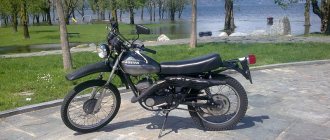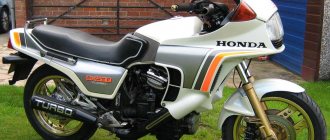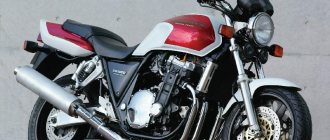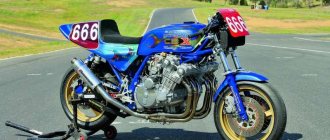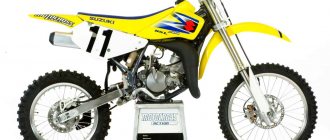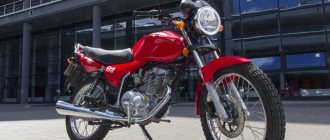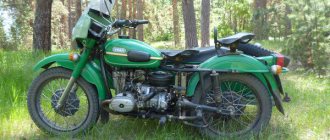| Honda CR125R (1998-1999) | Honda CR125R (2000-2001) | Honda CR125R (2002-2007) |
Model of a 2-stroke motocross motorcycle Honda CR125R
begins its history in 1974, when this model was first introduced to the market. Modern modifications of the Honda CR 125 R were produced from the 90s of the last century until 2007. Since 1998, these motorcycles received an aluminum frame, which was improved and made lighter in subsequent years.
A special feature of the Honda CR125R motorcycle is a 1-cylinder, 2-stroke, liquid-cooled engine producing 41 hp. power and 27 Nm of torque. The model also had modern sports suspensions, in particular, an inverted Kayaba fork, which had a full range of adjustments.
The “older” model is the Honda CR250R.
The main competitors of the Honda CR 125 R in the class:
- Suzuki RM 125
- Yamaha YZ 125
- Kawasaki KX 125
Appearance
Honda CR 125 is very similar to CR 85. Same frame color scheme: red, light gray and black. Except there's more black. Typical design, typical dimensions and fit - in a word, a classic cross-country bike. The only difference between it and modern models in this regard is that the CR 125 and its contemporaries once set a trend that motorcycle manufacturers still follow.
Like the CR 85, the plastic is cheap, but it doesn't feel like it's of poor quality. It’s just that more expensive motocross bikes have a plastic that is nicer to the touch and more pleasing to the experienced eye to look at. No more.
Comfort
The model is ergonomic for its class. Of course, when compared to road bikes, any motocross bike will lose. As for driving, it is convenient with the caveat that a person knows how to operate such equipment, in particular, how to take off.
The motorcycle handles hills and other uneven terrain well, and riding across the field is a pleasure. Huge suspension travel along with high ground clearance make the model an excellent choice for off-road use. But it would be impractical to use this bike for riding on regular roads. You will have to refuel often and endure the inconvenience of a specific landing, which is not justified in any way on a flat road.
Flaws
- Relatively high price.
- The piston and connecting rod require frequent replacement.
- The absence of a gyroscope requires special care when overcoming jumps.
- You cannot move around the city and highways due to the lack of mirrors.
Honda cr 125 r is an ideal option for those who, after youth, decided to continue to engage in motorsports. The device is distinguished by its reliability and durability, as well as ease of operation. The powerful engine is quite dynamic. The characteristics of the Honda CR 125 r contribute to a vibrant, dynamic ride on any surface. Due to its light weight and good handling, the bike is suitable for performing stunts.
The motorcycle is durable and has proven itself in tests. The absence of plastic allows you not to worry about the appearance, the main thing is that the fall does not cause injury to the driver. Riding a road motorcycle will bring a lot of pleasure to motorsport connoisseurs.
Dimensions and weight
The motorcycle is light and small in size, but it is still important to think ahead about how it will be transported to the race track. Not every car can accommodate such equipment. If you plan to store the bike somewhere nearby, everything is much simpler.
Dimensions:
- tank – 7.7 l;
- ground clearance – 345 mm;
- curb weight – 95.7 kg;
- height – 1278 mm;
- width – 826 mm;
- length – 2151 mm;
- seat height – 947 mm.
The tank volume is not that small, but it is not conducive to anything other than sporty off-road driving. The dimensions are average for the class, and it is fair to note that it was this model, along with some others, that once set the standards for size and weight that are still used today.
Model range 2007
motorcycles for cross-country and off-road riding includes about ten machines with a cubic capacity from 50 to 650 cm3.
The most powerful device - the Honda XR650R (since 2000) - is equipped with a “charged” four-stroke liquid-cooled engine with a power of 61.2 hp, which is installed in a duplex frame made of aluminum alloy. Based on this model, a version with the simplest lighting technology for enduro competitions is produced.
Honda CRF450R and Honda CRF250R models with four-stroke engines appeared in the concern's program recently (CRF450R - for the 2002 season, 250 cc modification - a year later), but changes are made to their design every year. Both cars are structurally similar: single-cylinder liquid-cooled engines with a Unicam valve drive system (in which the “overhead” camshaft cams directly act on the intake valves, and the exhaust valves are driven through short rocker arms), separate lubrication circuits for the engine itself and the gearbox. Also similar are aluminum frames of a semi-duplex design with powerful diagonal elements, front two-chamber Showa cartridge forks (wheel travel 315 mm), Pro-Link rear suspension with a fully adjustable Showa monoshock absorber. For the 2007 season, the motorcycles received carburetors with a new accelerator pump, modified cylinder heads, and reinforced clutch baskets. The suspension settings have also been changed, and a new lever mechanism for driving the main brake cylinder has made it possible to increase the braking force by 15%. Based on these machines, the CRF450X and CRF250X models are produced for enduro competition.
The Honda CRF150F and Honda CRF230F sports and recreational off-road motorcycles have been produced for the US market since 2002. A simple four-stroke “air vent” is installed in a steel tubular frame, forked at the bottom. The rear suspension is Pro-Link systems, with an aluminum alloy swingarm, and the rear brake is drum. The electric starter is installed only on the CRF230F modification; the engine of the CRF150F model is started only by a kickstarter.
The Honda CR250R, popular all over the world and here, is equipped with a highly accelerated two-stroke liquid-cooled engine with a power valve in the exhaust system, which produces 59.3 hp. The frame is made of aluminum alloy, the front fully adjustable fork is of an inverted type, and the rear suspension is of the Pro-Link system. The modification of the “octagonal” cubic capacity CR125R is similar.
A new product in the concern’s production program is the Honda CRF150R with a 150 cc four-stroke engine. In the future, such engines should displace the 85 cc two-stroke engines currently in use. The Unicam mechanism, known from older models, is used in the engine cylinder head. The lubrication system has different circuits for the engine and transmission. The Keihin FCR flat-spool carburetor is equipped with a throttle position sensor. The lightweight steel frame is complemented by a removable subframe. The Showa front fork is an inverted cartridge type. The Pro-Link rear suspension features a fully adjustable Showa monoshock and an aluminum alloy swingarm. The motorcycle is available in two modifications (CRF150R and CRF150R2), differing in wheel sizes. The dual-purpose motorcycle Honda XR125L is more of a scrambler than a sports machine: it has a “calm” four-stroke low-powered “air vent” of the OHV/2 design, a rear drum brake, and modest suspension travel. But the motorcycle is equipped with lighting equipment and is quite suitable for road riding.
For amateurs and novice athletes, the Honda CRF100F with a simple four-stroke “air blower” with a power of about 10 hp, installed in a steel tubular frame. The brakes are “no frills,” drum brakes. Even simpler is the 80cc version of the CRF80F.
For junior competitions, a fairly “serious” Honda CR85R with a powerful (21.6 hp at 12,000 rpm) two-stroke liquid-cooled engine installed in a steel tubular frame. The gearbox is six-speed, both wheels (17/14 inches) are equipped with disc brakes. The R2 version has wheels of larger diameter - 19 and 16 inches.
The children's model Honda CRF50F (since 2003) is designed to acquire first off-road driving skills. The world's most popular four-stroke engine in the Cub family (since 1962) is combined with a three-speed gearbox and an automatic centrifugal clutch. The power unit is suspended from a steel backbone frame, the wheels with a diameter of 10 inches are equipped with drum brakes. A modification for older children, CRF70F, is available. Cross-country bikes on these machines (they are called “pit bikes”) are extremely popular in America, they are gaining momentum in Russia, however, we mostly use similar machines from Chinese companies.
Specifications
The bike has a very fast acceleration to 100, which makes the car not the best choice for beginners. Even a smaller bike in this series (the 85th) can unpleasantly surprise an unlucky rider right at the start. The maximum speed here is not high, but it is enough for both amateur driving and racing.
| Rear brakes | one disc, 240 mm |
| Front brakes | one disc, 240 mm |
| Rear suspension | progressive pendulum, 318 mm |
| Front suspension | inverted fork, 305 mm |
| Overclocking | in 4 s to 100 km/h |
| Speed limit | 130 km/h |
| Torque at the limit | 27 Nm |
| Power to the limit | 41 hp |
| Steps in a box | five |
| Drive type | chain |
| Fuel consumption | 5.5 l per 100 km |
The technical characteristics of the machine were impressive at the time of its appearance. Since then, a lot has changed for the better. And even in the twenty-first century, the bike is not blameworthy in any aspect.
Brief history of the model
Since older Honda CR125R models are very different from modern versions of the motorcycle, it is recommended to review the revision history starting from the year the aluminum frame was installed. It is this change that makes the Honda CR125R a full-fledged cross-country sports equipment.
- 1998 - the motorcycle receives a first-generation aluminum frame and a new 5-speed gearbox.
Model
: Honda CR125R (all markets).
Factory designation:
CR125RW.
- 1999 - no significant changes.
Model
: Honda CR125R (all markets).
Factory designation:
CR125RX.
- 2000 - the motorcycle receives a second generation aluminum frame. The plastic and exhaust valve drive are changed.
Model
: Honda CR125R (all markets).
Factory designation:
CR125RY.
- 2001 - no significant changes.
Model
: Honda CR125R (all markets).
Factory designation:
CR125R1.
- 2002 - the model is equipped with a new third-generation aluminum frame, new plastic, engine and receives a new carburetor - Mikuni TMX 38.
Model
: Honda CR125R (all markets).
Factory designation:
CR125R2.
- 2003 - no significant changes.
Model
: Honda CR125R (all markets).
Factory designation:
CR125R3.
- 2004 - the exhaust valve is electronically controlled.
Model
: Honda CR125R (all markets).
Factory designation:
CR125R4.
- 2005 - The Honda CR125R model undergoes major changes. The engine is updated, the exhaust valve again becomes mechanical, and the front suspension now features a 46 mm Kayaba inverted fork.
Model
: Honda CR125R (all markets).
Factory designation:
CR125R5.
- 2006 - no significant changes.
Model
: Honda CR125R (all markets).
Factory designation:
CR125R6.
- 2007 is the last year of production.
Model
: Honda CR125R (all markets).
Factory designation:
CR125R7.
What do the owners say?
Those who have ridden models before and after 1998 say that they are like different motorcycles. Of course, if a person has previously ridden a sportbike or a car of a different class, this difference is unlikely to be noticeable to him. Judging by the reviews from experienced owners, most liked the changes.
It is advised to take more modern copies (after 2005). There are fewer problems with them, and the likelihood of getting a relatively new bike is higher. They note that the model is inexpensive. About 70 thousand Russian rubles - that’s how much such equipment costs. But even if they ask for more for a decent copy, it might be worth agreeing, because, judging by the photos and videos, many of these models are in poor condition.
IMPORTANT! One review says that once, when hitting a bump, both seals flew out. Perhaps the bike already had signs of damage that the owner had not previously noticed. And this once again shows how important it is to carry out maintenance and inspection on time, and also to always have funds for spare parts.
According to the description of those who have tried to use such a bike as a universal one, fuel consumption is affordable. So it is advised to buy this motorcycle only for the race track and if there is something to transport it there.
CR 125 is an interesting bike from Honda, with a long history. Now this is an outdated car, but it is still able to compete with modern models. A good reputation and high quality workmanship will ensure the popularity of this model for decades to come. But only on the secondary market.
1997 Honda CR125 Specifications
The CR125R, one of Honda's smallest motocross bikes, arrived in 1997 with new features that improved it over previous versions. Honda motocross bikes' model numbers roughly correspond to engine size, and the CR125R is 125cc. The CR125R came in Honda's red and white racing colors.
engine
Engine Honda CR125R 125 cc. The 1997 See was a single-cylinder engine that ran two strokes with a Honda Power Port (HPP) and used a liquid cooling system. A two-stroke engine uses one downstroke and an upstroke to fire once - the downstroke draws the fuel and air mixture out of the crankcase, and the upstroke compresses the fuel and air mixture and prepares it for ignition. Bore and stroke were 2.12 inches by 2.14 inches, and the engine's compression ratio was 8.8:1. The bike also had a 1.42-inch flat-sided reed switch in the crankcase for the fuel system and carburetor. The reed switch controlled the release of the compressed fuel-air mixture into the crankcase and ultimately into the combustion chamber. The CR125R's ignition system used a solid-state digital igniter and an electrical advance. You can start a motorcycle with a kickstarter.
Gearbox and gears
The low-ratio Honda CR125R transmission used a No. 520 chain on the gear-driven primary drive and had five speeds. The gearbox was also 12T/49T. The bike had a hydraulic, wet clutch with multiple plates. A wet clutch is a type of clutch that allows oil from the transmission to get between the plates and makes them sticky and wet. Riders had to hold the clutch to allow oil to drain from the plates before using the bike to prevent the gears from snagging.
Chassis
The CR125R chassis had a seat height of 37.4 inches and the bike's ground clearance was 13.9 inches. Single disc brakes were used on the front and rear wheels, and two-piston calipers were used on the front wheels. The overall wheelbase was 56.8 inches and the bike weighed 192.9 pounds. without fuel. Honda used Kabaya suspension parts in the CR125R. The rear suspension was a Pro-Link single-shock suspension and included spring preload. The rear suspension offered 12.6 inches of travel and had eight low-speed positions and two high-speed positions. The front suspension used a 1.81-inch inverted fork, had 12.2 inches of travel, and offered 20 compression positions. The CR125R's fuel tank can hold up to two gallons.
Related articles:
- Specifications of 1998 Honda CR 125R
- Honda XR100R Specifications
- Honda Z50R Specifications
- Specifications for Honda XR80R
- Honda Shadow VT700 Specifications
- XR 80 Technical data
